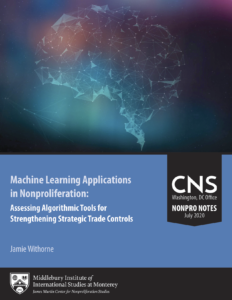August 4, 2020
Jamie Withorne
Machine learning and artificial intelligence have recently made significant advances in the fields of data science and data analysis. Applying machine learning algorithms to issues of nonproliferation has the potential to pave the way for innovative solutions within the field of nuclear policy.

Machine Learning Applications in Nonproliferation:
Assessing Algorithmic Tools for Strengthening Strategic Trade Controls
While nonproliferation is complex work done by a variety of organizations and requires an incredibly vast amounts, and different types of data, this report focuses on applying machine learning tools to supplement existing strategic trade controls on dual-use goods. When implementing strategic trade controls, it can be difficult for relevant officials to accurately and efficiently identify individual, controlled items, particularly when items are dual-use in nature. Images of these items are publicly available online, but officials do not necessarily use such resources in screening potential items of concern, nor do they always have the technical expertise necessary to positively identify controlled items. This report seeks to begin to address challenges in identifying proliferation-sensitive goods by applying machine learning image classification models.
Specifically, the goal of the research team was to assess the potential utility of machine learning algorithms to classify relevant images of dual-use good as a supplementary tool for detecting potential violations of strategic trade controls.
The models developed and discussed in this report are algorithms that autonomously classify images using a type of predictive analysis. Analyzing these models demonstrates how machine learning image classification tools may supplement traditional strategic trade controls to bolster nonproliferation efforts. Using Python and advanced analytics, the report demonstrates how machine learning applications can strengthen US nonproliferation commitments.
The report details: relevant dual-use items of interest and selection methodology, a dataset of weapons of mass destruction-related equipment, successful machine learning model development and evaluation, and potential wider applicability of machine-assisted identification for nonproliferation-related uses.
Download the report
Machine Learning Applications in Nonproliferation
View more in the the Nonpro Notes series
Keywords: machine learning, artificial intelligence, predictive analysis, advanced analytics, python, nonproliferation, dual-use, export control, international trade
